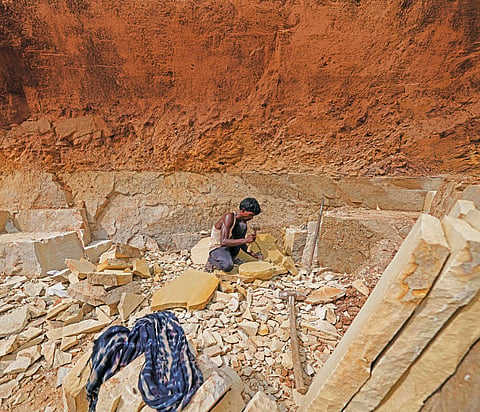‘Ramming mass industry is fatal for workers’
Twenty-two years ago, I began addressing silicosis in India’s ramming mass industry, driven by my father’s experience of witnessing its devastating effects in our family’s factory, Carr Glass Works, in Kolkata and Osaka, Japan. Ramming mass is a mixture of fine silica dust particles that have a size smaller than 500 Mesh and granules of 40, 30, 24, 16, 8, and 4 Mesh, produced by manually breaking, milling, crushing and disintegrating quartzite stones/rocks that contain 98.9 to 99.5 per cent silicon dioxide. It is widely used in the production of refractory materials, which can withstand high temperatures and chemical corrosion, making it essential for furnace linings and other high-temperature resistant/control applications. However, the manufacturing process generates high levels of fine silica dust, which can become lodged in the lungs, posing a severe health hazard to workers in the industry.
The earliest documented case was that of Badal Soren from Taldih Tola in Terenga village, East Singhbhum district, Jharkhand who died of silicosis on November 23, 2002. Another worker, Pradhan Hembram from Khariadih in the same village, succumbed to the disease on May 14, 2003. The death toll quickly escalated, and by August 3, 2007, at least 20 workers had died from a single plant in Jharkhand, KK Minerals, a ramming mass unit, which started production in 1998. In 2008, the X-ray plates of all the deceased workers were examined at Belur ESI Hospital, which confirmed that they were suffering from silicosis. Shockingly, all the workers died prematurely, at an average age of about 33 years.
Following an intervention by the National Human Rights Commission in June 2014, government doctors identified 30 deceased silicosis victims, 27 affected workers and 12 at-risk workers. Their medical reports were submitted to the Commission, leading to the announcement of financial relief for some victims and their families. However, the families of 39 workers have yet to receive compensation. The Jharkhand plant had two groups of workers—migrants who lived and worked inside the plant and locals who returned home at the end of the day. The Commission found that migrant workers from West Bengal developed silicosis within eight to twelve months due to continuous exposure to silica dust. We observed similar patterns among non-migrant workers from Minakhan and Sandeshkhali villages in North 24 Parganas district, West Bengal, who worked in three ramming mass industries in the Asansol subdivision of West Burdwan district.
What we now know, based on the occupational and clinical histories of workers in the ramming industry, is that they are exposed to extremely high concentrations of silica dust, between 98.99 and 99.5 per cent. Based on this, the Occupational Safety and Health Association of Jharkhand (OSHAJ INDIA), a non-profit I started, has challenged the conventional definition of silicosis, which attributes the disease solely to prolonged exposure. Instead, OSHAJ INDIA proposed a revised definition: silicosis is a specific form of pneumoconiosis caused by both short-term and long-term inhalation of airborne crystalline silica dust, which deposits in the alveoli. Fibrous tissue formation around these particles obstructs oxygen-carbon dioxide exchange, leading to respiratory distress. The severity of silicosis depends on multiple factors, including silica concentration, dust levels, duration of exposure and workers’ immunity.
Despite the World Health Organization (WHO) and the International Labour Organization (ILO) launching a global plan in 1995 to eliminate silicosis by 2025, India’s efforts remain inadequate. The country has no comprehensive database on silicosis cases. Government initiatives have been largely confined to academic studies and seminars, with little meaningful action. It is imperative that the government enforces workplace safety regulations and mandates plant and machinery upgrades to ensure zero emissions of silica dust. Such measures are critical, especially given that, in 2015-16, an estimated 11.5 million were engaged in silica dust-exposed occupations in India—a figure projected to reach 52 million by 2025-26.
As doctors in India commonly believe that silicosis occurs only through prolonged inhalation of silica dust, they fail to recognise ramming mass workers as silicosis patients. Instead, the doctors frequently misdiagnose them with TB in medical records, depriving them of their rightful access to social security benefits.
(Samit Kumar Carr is the founder-general secretary of non-profit Occupational Safety and Health Association of Jharkhand)
This was first published as part of a cover story on silicosis titled ‘Dust To Dust’ published in the 1-15 April, 2025 print edition of Down To Earth

